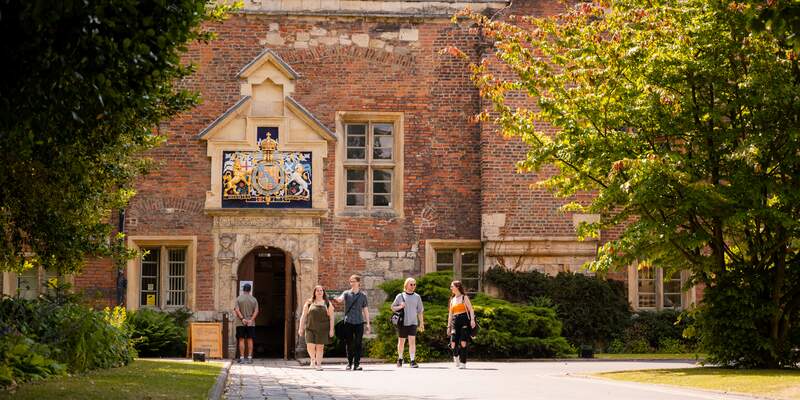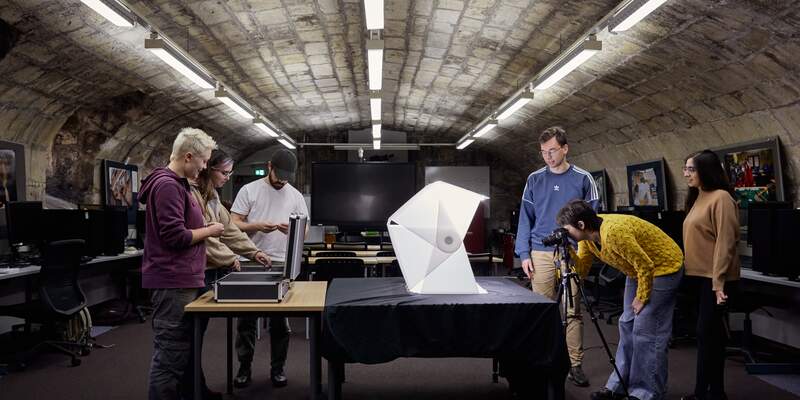
King's Manor
King’s Manor is a group of Grade I listed buildings nestled in the heart of the city centre. It's located between York Art Gallery and York Museum Gardens.
Its history can be traced back to medieval times when it was built to house the abbots of St Mary’s Abbey. Today, it’s home to three of our academic departments and is a site of world-leading teaching and research into the past. King's Manor also plays host to conferences, meetings and events.
Related links
Research and teaching at King’s Manor
Three research and teaching departments are based at King's Manor:
The Archaeology Data Service, a prestigious national service providing digital resources to archaeology researchers, is also based here. The proximity of important city institutions like York Minster, York Art Gallery and the Yorkshire Museum is a benefit to study initiatives, collaboration, shared facilities and new opportunities.

Digital Archaeology and Heritage Lab at King's Manor
Research and teaching facilities at King's Manor include:
- a networked computer room with 18 PCs, and wireless internet access in most parts of the Manor
- a library with a stock of over 22,000 books and important collections of slides and photographs
- dedicated work areas for postgraduate students in each discipline
- a range of seminar and lecture rooms.

King's Manor Library
Public access to King’s Manor
King's Manor is open to the general public Monday to Friday from 8am (last entry 6pm), and Saturdays from 8.30am (last entry 4.30pm).
Public access is limited to the first courtyard, toilets and library. There are no catering facilities for visitors at King's Manor.
Conferences and events
King's Manor also plays host to conferences, meetings and special occasions, organised through York Conferences and Events. Facilities and services include:
- the 16th-century Huntingdon Room
- a range of fully-equipped meeting rooms with PCs, projectors, screens and laptop connections
- catering for up to to 90 delegates.
A brief history of King’s Manor
Originally the abbot's house of St Mary's Abbey, King's Manor served the Tudors and Stuarts as a seat of government, becoming residences in the 18th century and a school in the 19th century. The history of King's Manor has woven a continuous thread in the story of York since medieval times.
- 1539
St Mary’s Abbey is dissolved and the former Abbott’s house becomes the headquarters of the Council of the North. - 1541
Henry VIII visits with Catherine Howard and extensive building work is undertaken in preparation for their arrival. This visit gives the building its current name, ‘King’s Manor’. - 1561
King's Manor becomes the official residence of the President of the Council. - 1572 to 1595
Under the Earl of Huntingdon, residential wings and a service building are added, including the Huntington Room, which contains a platter frieze with the Earl of Huntingdon’s coat of arms.
- 1641
The Council of the North is abolished and its former buildings are used by a series of military governors in York. - 1642-1651
During the English Civil War, King's Manor becomes the Royalist headquarters in York and was the scene of fighting between Parliamentarian forces and Royalist defenders of the city. When Charles I was defeated in 1644 by Oliver Cromwell’s Parliamentarian forces at the Battle of Marston Moor, just outside York, the king lost control of the north of England and King’s Manor surrendered. - 1688
Parliament takes possession of King’s Manor, which is divided into apartments and leased to a series of York aldermen throughout the 18th century.
- 1813
The Manor School moves to King’s Manor and adopts its name. Anne Lister is sent to the school and it’s here she meets her first love, Eliza Raine. - 1833
The Yorkshire School for the Blind is founded and occupies King's Manor, kick-starting gradual restoration and expansion.
- 1900
The Principal's House is built by renowned York architect Walter Brierley. Today, it's home to the Centre for Medieval Studies. - 1956
The Yorkshire School for the Blind departs the site. - 1958
King's Manor is acquired by City of York Council. - 1962
King's Manor is leased to the University and major restoration takes place. - 1967
The Institute of Advanced Architectural Studies (later part of the Department of Archaeology) moves into King's Manor. - 1968
King's Manor becomes the home of the Centre for Medieval Studies. - 1970
Elton John and Fairport Convention played at the June Ball at King's Manor - 1995
The Department of Archaeology relocates to King's Manor. - 1996
The Friesian Calf statue by Sally Arnup (1930-2015) is installed. The calf is much loved by students, as its shiny nose suggests. - 1998
The Centre for Eighteenth Century Studies joins the growing scholarly community at King’s Manor.
This timeline was summarised from resources in the collections of the University Library and the Borthwick Institute for Archives at the University of York.